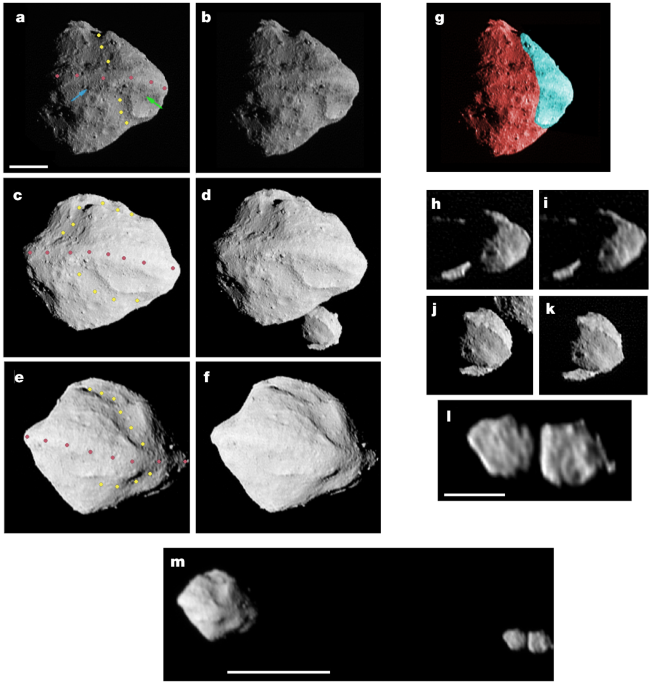Observations
The analysis presented here is based on panchromatic (350–850 nm) images taken with Lucy’s LOng Range Reconnaissance Imager, hereafter L’LORRI, which is a 20.8-cm, f/13 telescope feeding a 1,024 × 1,024-pixel CCD focal plane35. L’LORRI has a field of view of 0.29° and a pixel size of 5 µrad. It was primarily used in three distinct observation campaigns during the encounter. (1) Optical navigation reconstruction images were designed to precisely determine the trajectory of Lucy. They were taken daily during the period of ±4 days of encounter (tCA = −4 to +4 days) and every 15 min from tCA = −2 h to +2 h. (2) High-resolution close-approach images were taken every 15 s from tCA = −10 min to +9 min, then with 1-min cadence until +55 min. (3) Post-encounter light-curve photometry was acquired from tCA = +4 h to +95 h. Three exposures were taken at a cadence of 1 h. At this time, the Dinkinesh–Selam system was unresolved. To minimize data volume, these data were taken in L’LORRI’s so-called 4 × 4 mode, which bins the data by 4 × 4 pixels during the CCD readout.
Light-curve analysis
The orbital period of Selam and the rotational period of Dinkinesh can be determined using the post-encounter light-curve photometry described above in the ‘Observations’ section. Instrumental magnitudes of the system were extracted from the images using a 1.5-pixel-radius aperture. The small aperture served to exclude contamination from nearby stars. The formal errors from the extraction were scaled upward by a factor of 1.545 to adjust the reduced χ2 to be 1 before determining the final uncertainties on the fitted results. There were 267 images analysed.
The data were compensated for the changing distance as well as correcting to a constant solar phase angle using a phase coefficient of 0.06 mag per °. The phase angle varied from 60.52° at the start to 59.67° at the end. The observing direction changed little over the 3.5 days and these corrections remove these slight changes, leaving only a record of the global photometric properties of the system. The resulting light curve is shown in Extended Data Fig. 1 in units of relative flux.
We analysed the light curve with an iterative process designed to separate the contributions to the total flux from Dinkinesh and Selam. As the first step, a model was constructed that consisted of a Fourier series expansion of the light curve combined with a period for each object. The reference time for the rotational phase was arbitrarily set to the time of the first data point for both objects. The mean flux of Dinkinesh was a free parameter in the model. Also, we iteratively varied the Selam/Dinkinesh mean flux ratio. This ratio is constrained by the close-approach resolved images (Fig. 1d, for example), which show that the ratio of the visible areas of the two objects is 0.25. The two objects are also seen to have similar surface brightness, and so the unresolved flux ratio is also 0.25. This ratio was assumed to be at minimum light for both objects because Selam is viewed edge-on. An iterative correction was applied after separating the light curves to correct from the minimum to the mean flux and the final mean flux ratio was set at 0.33 (corresponding to a magnitude difference of 1.3).
The model parameters were determined in a series of iterative steps. The first pass fit set a reasonable mean flux for Dinkinesh and the Fourier terms were disabled. At this point, only Selam was free to be adjusted to fit the data. The data were scanned in period. At each step, a best-fit Fourier series was computed and the χ2 was recorded. The lowest χ2 period gave a preliminary value of 51.76 h for Selam. This model was subtracted from the light-curve data and a similar scan was performed on the Dinkinesh-only data. The Dinkinesh scan returned two interesting minima in χ2 at periods of roughly 3.7 and 4.3 h. Note that all periods assume that the light curve is double-peaked.
Given the two preliminary periods, the data were then fitted with the full model from the two objects and all free parameters were optimized simultaneously with an amoeba χ2 minimization (ref. 36 Chapter 10.4). Using the amoeba fit as the starting point with the a posteriori correction to the uncertainties, a second Markov chain Monte Carlo fit (see ref. 37) was run for the model. There were 18 data points that were excluded because of unreasonably large residuals (see the discussion below). The final fitted light curves revealed amplitudes of 0.82 mag for Selam and 0.25 mag for Dinkinesh.
The Selam rotation period was determined to be 52.44 ± 0.14 h from this fit, but it is also attributed to its orbital period about Dinkinesh because it is probably tidally locked, as shown by the presence of mutual events. The resulting phased light curves are shown in Fig. 2.
The variation in flux for the two objects coincidentally are about the same. Dinkinesh is much larger, which implies that it has a smaller relative variation in its flux. The light curve of Selam is well fit by two Fourier terms that capture the slightly asymmetric maximum and slightly broadened minima. The light curve of Dinkinesh is considerably more complicated; both the minima and maxima are asymmetric but there are also clearly higher-order variations seen. In this case, a four-term Fourier fit was required and even this does not fully capture all of the detail in the curve. For instance, one of the minima is sharper than can be followed with a four-term fit. The rotation period of Dinkinesh was determined to be 3.7387 ± 0.0013 h (the 4.3-h period discussed above was determined to be an alias).
The outliers that were flagged during the light-curve fitting, which are shown in red in the figures, are also of interest because they occur at a coherent rotation phase following a similar time after the two light-curve minima for Selam. A reasonable explanation for these low points is a mutual event between the two bodies. These could, in general, be from the bodies occulting each other from the perspective of the spacecraft or from casting shadows on one another. Fortunately, the timing of these minima allows us to determine which.
Looking at the photometry as a function of time, the low points appear at a regular interval at half the rotation period of Selam. Geometric constraints from the absolute timing indicate that the events are shadow transits of each other and not physical obscuration along the line of sight (occultations). Furthermore, the timing clearly indicates that the orbital motion of Selam is retrograde, as is true for the rotation of Dinkinesh as well. The first and third dips seen in time are inferior shadowing events, whereas the middle dip is a superior event. In the phased plot, the two inferior events overlay each other and trace out a more complete light curve of an event. The superior event has fewer measurements and shows an incomplete profile of the dip that misses the maximum eclipse point that must be in the middle between the two sets of points.
Shape
The digital shape model used for this study (see Fig. 3) was generated by applying classical stereophotogrammetry techniques (ref. 38 and references therein) to L’LORRI imagery. A total of 48 images with a best ground-sampling distance ranging from about 10 m per pixel to 2.2 m per pixel were chosen from the high-resolution close-approach images described in the ‘Observations’ section. These were used to establish a network of 3,000 control points, which served as an input for the bundle adjustment process. Further, thanks to the very good noise and sensitivity performance of the L’LORRI imager, and to its comparatively large field of view, we could identify about 20 catalogue field stars in the Dinkinesh fields throughout the encounter. These star positions were used in the determination of the stereophotogrammetric adjustment, and contributed considerably to stabilize the solution.
As a result, the camera extrinsic matrices were determined, which describe the transformation between the camera’s and the body-fixed reference system. These transformation matrices were then used to triangulate surface points from homologous image points, which were derived by means of dense stereo matching39. The resulting dense point cloud (about 5 × 106 3D points) was then connected into a regular triangular mesh. The shape model derived from stereo reconstruction has an estimated scale error of about 1.4% and covers about 45% of the body’s surface. To produce a closed shape, and allow an estimation of the body volume, the unseen hemisphere has been approximated with an analytical solid figure. For this purpose, we chose a generalized super-ellipsoid40, whose implicit representation is given by the function
$$1={\left|\frac{x}{a}\right|}^{k}+{\left|\frac{y}{b}\right|}^{m}+{\left|\frac{z}{c}\right|}^{n}$$
in which x, y and z are the standard Cartesian coordinates. A fit to the reconstructed hemisphere leads to a = 0.40, b = 0.40, c = 0.35 km, k = m = 2 and n = 1.35. The generalized super-ellipsoid provides a better match to the ‘top’ shape of Dinkinesh than a conventional triaxial ellipsoid.
We estimated the uncertainty in the volume of Dinkinesh from the difference between the shape model and the super-ellipsoid convex shell. For the hemisphere covered by imaging, the difference in volume is 4.7%. To be conservative, we round this and apply an arbitrary factor of two margin to arrive at the volume uncertainty of ±10%. This uncertainty is propagated to quantities derived from the volume. In particular, we note that the volume-equivalent radius of Dinkinesh is calculated as rveq = (3V/4π)1/3, rather than from direct distance measurements.
The dimensions of the two lobes of Selam were found by fitting ellipses to orthogonal axes in several resolved images of Selam from different viewing angles. The inner lobe of Selam is fit with an ellipsoid measuring 240 × 200 × 200 m. The outer lobe is measured at 280 × 220 × 210 m. Uncertainties were estimated to be 10% per axis by adjusting the ellipsoidal fits until they were visually too large or too small to match the images. Combining the above values, we calculate a total system volume of Vtot = 2.06 ± 0.20 × 108 m3.
Mass and density
System density can be estimated from the orbital period and relative semimajor axis of the two bodies. As we describe in the main text, the centre-of-figure separation between Dinkinesh and Selam was 3.11 ± 0.05 km at the time of the fly-by. The eccentricity of Selam’s orbit is not directly derivable from existing data, although it can be constrained. The regular phasing of the light-curve minima collected before encounter from the ground14 and from Lucy (Fig. 2) is consistent with a near-circular orbit, given our inference (Fig. 2) that these minima are caused by mutual eclipses. We would expect the eccentricity of Selam to be near zero, given that tidal timescales for orbit circularization are on the order of 106–107 years. The ages of asteroid pairs for which one of the members of the pair has subsequently undergone a mass-shedding event leading to the formation of a satellite suggest that binary-YORP effects41 might shorten the circularization timescale to less than about 106 years (refs. 16,42). Thus we assume e = 0 in the analysis performed here. Ground-based light-curve observations, taken at several epochs, can better constrain any orbital eccentricity that might exist.
Assuming that Selam is in a circular orbit about Dinkinesh and has an orbital period of 52.67 ± 0.04 h, we derive a system mass of 4.95 ± 0.25 × 1011 kg (GM = 33.0 ± 1.6 m3 s−2) from Kepler’s third law. In the ‘Shape’ section, we calculate a total system volume of Vtot = 2.06 ± 0.20 × 108 m3. Combining the system mass and volume, we derive a bulk density of ρ = 2,400 ± 350 kg m−3. We add the caveat that, if the assumption of zero eccentricity is incorrect and the separation observed at the time of the fly-by differs from the semimajor axis, it would introduce a systematic error into the calculation of density. Conversely, however, the range of likely density for an S-type asteroid, as discussed below, constrains the maximum eccentricity to be on the order of 0.1 and the assumption of zero eccentricity is fully consistent with known asteroid properties.
Angular momentum
Knowledge of the component masses and the spin state can be combined to calculate the angular momentum of the system. For simplicity, we assume that the moment of inertia of Dinkinesh can be adequately represented by a sphere of volume-equivalent radius. Assuming that Selam is tidally locked, the contribution to the angular momentum from its spin is small. Likewise, the orbital motion of Dinkinesh around the barycentre is small and we ignore it. The system angular momentum is nearly equally divided between the spin of Dinkinesh, Lspin = 11.2 ± 1.9 × 1012 kg m2 s−1, and the orbital motion of Selam, Lorb = 8.0 ± 4.0 × 1012 kg m2 s−1. The total angular momentum of the system is Lsys = 19.3 ± 4.4 × 1012 kg m2 s−1. The normalized angular momentum, αL, is computed from the total system angular momentum divided by the angular momentum of a sphere containing the total mass of the system rotating at the maximum rate for a cohesionless rubble pile43. That rate is given by ωmax = (4πρG/3)1/2, corresponding to a spin period of Tmax = 2.13 h, that is, the observed main-belt spin barrier. We find αL = 0.88, consistent with that expected for a binary produced by fission26.




